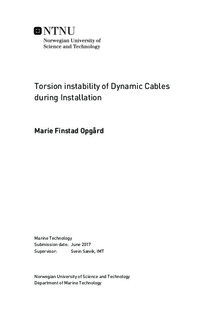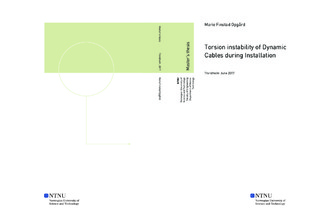| dc.description.abstract | The oil and gas industry today is a heavily regulated segment, and current standard hasestablished restrictions which yields a very limited weather window for offshore cable installations. This is due to experience with cable failure in harsh weather. A limiting factor in current practice is the design criterion for the minimum allowable radius of curvature in the touchdown point. In addition, current practice does not allow for occurrence of compression in the touch down zone, since this is associated with loop formation and loss of the functionality of the cable. The main purpose of this thesis is to investigate the validity and conservatism of current practice, by investigating the issues related to torsion instability through a proposed design procedure.
The scope of the thesis comprehends numerical analyses using the SINTEF OCEAN developed software SIMLA. The numerical studies concern a J-lay installation scenario at 100 meters water depth with an implemented cable laying vessel with realistic RAO properties. Two real-life cable cross-sections are evaluated; a single-layered cable without armoring (umbilical1) and a torsional balanced cable with double-armoring (umbilical 2). The mechanical properties of these are calculated analytically, where the main differences lay in the torsional stiffness of the cross-sections. The effect of installation route is evaluated, and two scenarios are simulated; an end cap turn and a curved route to avoid obstacles. The results are obtained in two steps. Primarily, the critical values of torsion momentand resultant curvature with respect to loop formation are established. These parameters are determined for both a linear and a non-linear pipe material model.
Subsequently a range of dynamic analyses with irregular waves are carried out. The irregular waves are applied using a Pierson-Moskowitz wave spectrum with Hs= 2−3mandTp=7−10s with a one hour simulation time. In the dynamic analyses, the torsion moment and curvature in the cable are analyzed and compared with the capacity parameters for each scenario. For umbilical 1 it is found that the maximum resultant curvature for all sea states exceeds the critical API curvature, while the torsion moment is below the critical torsion moment. The sea states can, due to excess of the API criterion, not be classified as acceptable. It is also concluded that a contributing factor is the low magnitude of the horizontal bottom tension. The maximum resultant curvature for umbilical 2 oscillates around curvature values below the design criterion for minimum radius of curvature for all sea states. The torsion moments are lower than the critical torsion moment. All seastates for umbilical 2 are categorized as acceptable with respect to experienced resultant curvature. It is in addition investigated whether the cables experience compression in the touch down zone while subjected to irregular waves. For umbilical 1 it is found that compression occurs inthe touch down zone for all sea states for both installation scenarios. Umbilical 2 experiences compression in varying degree for all sea states except for Hs= 2m,Tp= 7s. The magnitude of the compressive axial force is increasing in accordance with increasing wave height andperiod. The magnitude of the compressive axial forces experienced are compared with the buckling loads associated with local helix buckling and birdcaging. None of the force values are within the range for the buckling loads for tensile armour buckling. Hence it can be concluded that its possible with occurrence of compression without necessarily associated kink formation nor local buckling. The effect of wave heading is also investigated. Changing the wave heading impacts the maximum resultant curvature. It is found that the most critical scenario occur when the waves are incoming with a heading of [π,2π]. This is due to the cable configuration, which experience a slight bend in the touch down zone at the initiation of the dynamics. It is also carried out a study of the effect of additional sea current. A current velocity of 4m/s with correspondingly heading of 0°, 90°, 180°, 270° is applied. This result in the observation that the most critical scenario is a current heading of 180° due to reduction of the cable effective weight. It is investigated whether a too low horizontal bottom tension is the reason of the severe curvature levels for umbilical 1. Analyses with a T0= 5kN are run for the respective sea states. Resulting from this the curvature levels for umbilical 1 is lowered to acceptable levels for Hs= 2m. The same analyses are carried out for umbilical 2, where the resulting curvatures increase compared to lower initial tension. This is due to severe yielding of the friction moment for the case of T0= 5kN, inducing more severe deformation of the cable. | |

